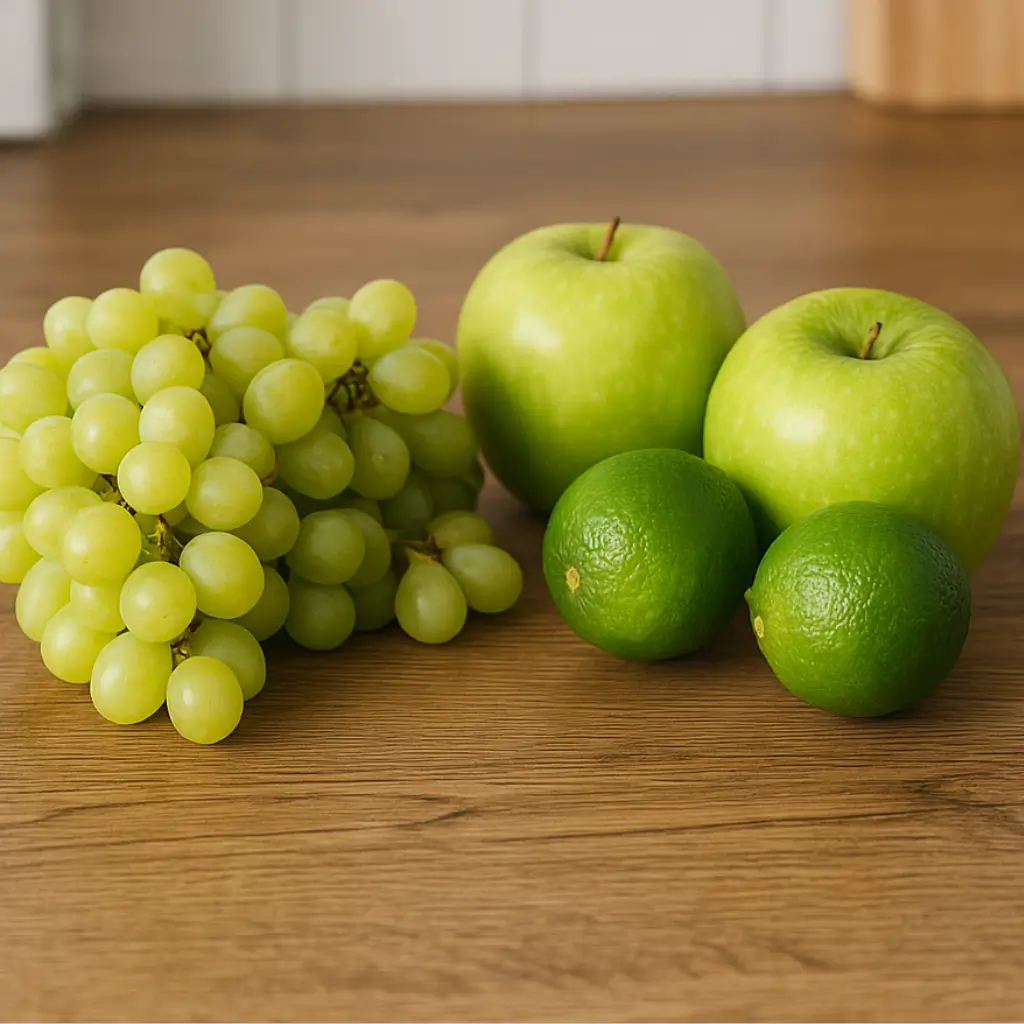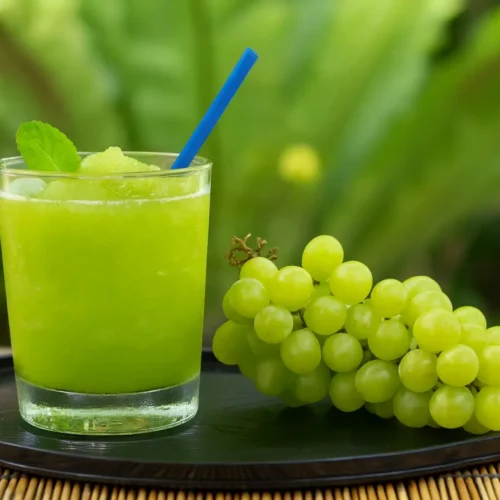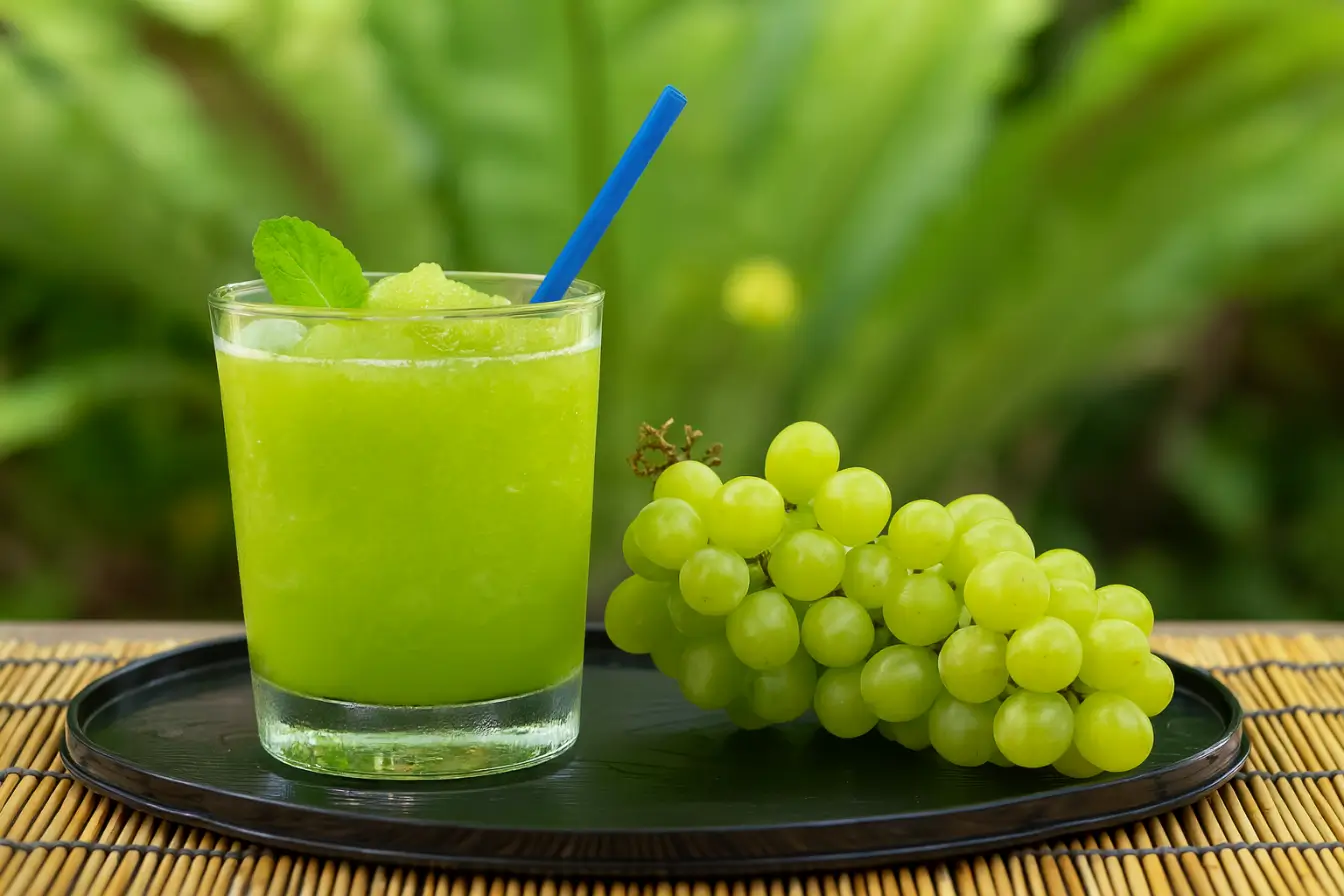There’s something about sipping green grape juice on a hot day that feels like hitting pause on the world. It’s crisp, lightly tangy, and has that balance of sweet and sour that wakes you up without overwhelming your taste buds. Unlike store-bought bottles that are usually packed with sugar or preservatives, making it at home gives you a clean, refreshing drink you can actually feel good about.
This recipe is especially perfect for anyone who wants more than just a “healthy drink” — it’s for the curious cook who enjoys experimenting with fresh produce, the health-conscious eater who wants vitamins without added sugar, and honestly, anyone who just wants a glass of something cooling after stepping out in the summer sun.
In the next few minutes, you’ll see how to make this simple three-ingredient juice, explore variations that fit your taste, and learn why grapes, limes, and apples aren’t just delicious together but also a powerhouse mix for your body. We’ll also look at different preparation methods (juicer, blender, even boiling), some cultural takes on sour grape drinks, and practical tips for making it part of your daily routine.
So, whether you’re here because you typed “green grape juice recipe” into Google, or you’re just curious if this drink is really as good for you as people say — you’re in the right place. Let’s dive in.
Table of Contents
Ingredients for Homemade Green Grape Juice
The beauty of this recipe is its simplicity — just three everyday fruits come together to create a surprisingly complex drink. Each one has its own role to play, both in flavor and nutrition.

Green Grapes (2 pounds, seedless)
These are the backbone of the juice. Fresh green grapes bring natural sweetness and a crisp, slightly tart edge that makes the drink refreshing instead of heavy. They’re rich in antioxidants like resveratrol and flavonoids, which have been linked to better heart health and reduced inflammation. Plus, grapes are hydrating — about 80% water — making them a natural thirst quencher.
Organic Limes (2 whole, peel optional)
Limes give this juice its signature sour kick. Using the peel intensifies the flavor and adds extra antioxidants, though it can introduce a faint bitterness. Nutritionally, limes are packed with vitamin C, which supports immunity and collagen production. They also have a balancing effect on the body’s pH and are often used in natural detox drinks.
Granny Smith Apples (4–5 medium, unpeeled)
Granny Smiths round out the flavor with their tartness, keeping the juice bright and lively without added sugar. Apples are high in dietary fiber and vitamin C, plus they contain polyphenols that may help with blood sugar regulation. Their sharp flavor also helps balance the sweetness of grapes, so the juice never feels cloying.
Do I need to peel the limes and apples?
Not necessarily. Keeping the peels on adds nutrients and fiber, but it can make the juice slightly more bitter. If you’re new to juicing, try it both ways and see which you prefer.
How to Make Sour Green Grape Juice
This recipe couldn’t be simpler, but the way you prepare it does make a difference in taste and freshness. The key is clean produce and a smooth juicing process.

Step 1: Wash Everything Well
Even if your fruits are organic, give them a thorough rinse. Grapes, in particular, can hold onto a lot of residue, and since we’re using whole limes and unpeeled apples, it’s worth scrubbing them lightly under running water.
Step 2: Juice the Ingredients
Using a juicer, feed the grapes, limes, and apples in alternating order. This helps the juicer extract liquid evenly and prevents clogging. You’ll notice the color is a light, almost glowing green — that’s when you know it’s fresh.
Step 3: Strain (Optional)
If you like your juice silky smooth, pour it through a fine mesh strainer or cheesecloth. Personally, I don’t always bother — the light pulp adds body and makes it feel more natural. But if you’re serving it to guests, straining can give it a cleaner finish.
Step 4: Serve & Enjoy

Pour the juice into chilled glasses, add ice if you like it extra cold, and serve right away. The flavor is at its brightest within the first 24 hours.
Quick Tip
Taste the grapes before juicing. If they’re on the sweeter side, reduce the number of apples. If they’re very tart, add one extra apple to balance things out.
Tips & Tricks for the Best Green Grape Juice
Even though this juice is simple, a few small choices can make the difference between “good” and “wow, that’s refreshing.” Here’s what I’ve learned from trial and error:
Pick the Right Grapes
Not all green grapes taste the same. Some batches lean sweeter, others are sharp and sour. If you want a bold, tangy juice, go for firm, slightly under-ripe grapes. For a softer, sweeter juice, let your grapes ripen fully before juicing.
Balance Sweet and Sour
Think of this juice like a sliding scale: grapes bring sweetness, apples add tang, and limes deliver that sour punch. If your first batch tastes too sweet, add an extra lime. Too sour? Toss in half an apple more. The fun part is adjusting it until it tastes just right to you.
Serve it Ice-Cold
This juice really comes alive when chilled. Pour it over ice, or store it in the fridge for at least 30 minutes before serving. Adding a slice of lime or a few frozen grapes as “ice cubes” makes it extra refreshing and visually appealing.
Store it Smartly
Fresh juice is always best enjoyed right away, but if you’re prepping ahead, store it in an airtight glass jar filled close to the top to reduce oxidation. It’ll keep its flavor and nutrients for up to 3 days in the fridge.
Can I freeze green grape juice?
Yes, but freeze it in plastic containers instead of glass to avoid cracking. Frozen juice will last about 2 months, though the texture may be slightly thinner once thawed.
Substitutions & Variations for Green Grape Juice
One of the best parts about homemade juice is that it’s flexible. You can swap fruits, add herbs, or even turn it into a mocktail depending on your mood. Here are some easy ways to mix it up:
Fruit Swaps
- Grapes: Any variety works. Red or black grapes will give you a deeper color and sweeter flavor. Cotton candy grapes make it taste almost like dessert.
- Citrus: No limes on hand? Use lemons, or even oranges, for a sweeter, less tart twist.
- Apples: Stick with Granny Smith for a tangy bite, or try Fuji or Honeycrisp if you prefer a naturally sweeter juice.
Flavor Boosts
- Fresh Herbs: Mint, basil, or even rosemary can give your juice a refreshing or aromatic lift.
- Cucumber: Adds volume without extra sugar or calories, while keeping the drink ultra-hydrating.
- Spice Kick: A thin slice of jalapeño or a pinch of cayenne gives the juice a surprising, margarita-like heat.
Mocktail Upgrade
If you’re looking for something party-ready, top your green grape juice with sparkling water or club soda, then garnish with lime wheels. It turns into a light, bubbly mocktail that feels far more festive than plain juice. For another tropical-inspired alcohol-free drink, don’t miss our Virgin Piña Colada Recipe — creamy, refreshing, and perfect for summer gatherings.
Can I combine green grape juice with other fruit juices?
Absolutely. Pineapple, pear, or melon juices pair especially well because they complement the grape’s tartness without overpowering it.
Best Combinations: Fruits That Go Well with Green Grapes
Green grapes are surprisingly versatile. On their own, they’re refreshing — but when you pair them with the right fruits, the flavor opens up into something even more interesting. Think of grapes as the “neutral friend” at a party: they blend in easily, but they also make others shine.
Classic Pairings
- Apple + Grape: Crisp and tangy, perfect for balanced sweetness.
- Pear + Grape: Smooth and mellow, almost dessert-like.
- Pineapple + Grape: Tropical twist with a sweet-sour punch.
- Melon + Grape: Hydrating, light, and perfect for hot weather.
Citrus Additions
- Orange: Adds brightness and a touch of sweetness.
- Grapefruit: Makes the juice sharper and more energizing.
- Lemon: A softer alternative to lime if you prefer less bite.
Herb & Spice Pairings
- Mint or Basil: Fresh, cooling undertones.
- Ginger: A zingy edge that pairs well with the grape’s sweetness.
If you’re experimenting, start small. Mix grape juice with just one other fruit juice at a time until you find your favorite blend. Once you hit a good combo, you’ll know — the flavor just clicks.
What fruit is best with green grapes for juicing?
Apples are the easiest match, but pineapple is often the favorite for its bold flavor and natural sweetness. Both make the juice more balanced and less sour.
Cultural Note: Green Grape Drinks Around the World
While this recipe is a modern, cold-pressed take, green grape drinks have roots in different food traditions. Exploring them gives the humble grape juice a sense of place and story.
Korean Green Grape Drinks
In Korea, grapes are often transformed into refreshing beverages, especially in summer. You’ll find cheong (a traditional fruit syrup made by fermenting fruit with sugar) used to create sparkling green grape drinks. They’re sweet, tangy, and slightly fermented — closer to a soda than plain juice. Convenience stores even sell ready-to-drink green grape sodas and sparkling waters because the flavor is so beloved.
Mediterranean Sour Grape Juice
In Mediterranean and Middle Eastern cuisines, sour grape juice (sometimes made from unripe grapes, also called verjuice) has a long history. It’s been used as a cooking ingredient for centuries, adding acidity to dishes before lemons were common. While less of a “drink” and more of a culinary staple, verjuice shows how grapes can be celebrated in different forms — from sipping to seasoning.
A Universal Theme
What these traditions share is the idea of using grapes not just for sweetness, but for their sour, tangy character. It’s a reminder that this juice can be more than a casual summer drink — it can connect you to culinary traditions that span continents.
Is green grape juice the same as verjuice?
Not exactly. Verjuice is made from unripe grapes and is mostly used in cooking, while green grape juice (like this recipe) comes from ripe grapes and is meant for drinking.
Nutritional Benefits of Green Grape Juice & Daily Drinking Advice
One of the biggest reasons people turn to homemade green grape juice is for the health boost. Unlike packaged versions that are often spiked with sugar or stripped of nutrients, this cold-pressed juice keeps things clean and intact.
Key Nutritional Highlights
- Rich in Vitamin C: Supports your immune system and helps your skin stay vibrant by boosting collagen production.
- Vitamin K Source: Important for bone strength and healthy blood clotting.
- Antioxidants: Grapes are packed with resveratrol, flavonoids, and polyphenols — compounds linked to reduced inflammation and better heart health. As noted by Harvard Health Publishing, grapes offer strong anti-inflammatory benefits and provide essential nutrients like vitamins C and K.
- Hydration: Grapes are about 80% water, making this juice naturally thirst-quenching.
- Digestive Support: Apples add fiber and compounds that can help with gut health and smoother digestion.
Looking to include more cleansing juices in your weekly routine? Our guide on Juice Cleanse Recipes That Work Wonders for Detox & Glow shares additional blends designed to boost hydration, skin health, and energy.
Can You Drink It Every Day?
Technically, yes. A glass of green grape juice can be a refreshing part of your daily routine. But — and here’s where balance comes in — grapes and apples both contain natural sugars. Drinking it occasionally as a healthy treat is ideal, especially if you’re mindful of blood sugar levels. If you want to enjoy it daily, try diluting it with water or sparkling water to cut the sugar concentration while keeping the flavor.
The presence of flavonoids, procyanidins, and resveratrol in grapes may also support blood vessel function and heart health. According to Harvard Health Publishing, both grapes and grape juice can help protect cardiovascular health in a similar way to wine — just without the alcohol.
Quick Nutrition Snapshot (per 8 oz serving, approx.)
- Calories: ~120
- Carbohydrates: 28–30 g
- Natural Sugars: ~24 g
- Vitamin C: 15–20% DV
- Vitamin K: 10–15% DV
Is green grape juice healthier than store-bought grape juice?
Yes. Store-bought versions often contain added sugars, preservatives, and concentrates. Homemade juice keeps all the fresh nutrients intact without unnecessary extras.
Recipe Card: Homemade Sour Green Grape Juice

Homemade Sour Green Grape Juice
Equipment
- Juicer
- Fine mesh strainer or cheesecloth (optional)
- Glass jars for storage
Ingredients
Juice Ingredients
- 2 pounds Green seedless grapes Washed thoroughly
- 2 whole Organic limes Juiced whole, peel optional
- 4-5 medium Granny Smith apples Unpeeled, washed
Instructions
- Step 1: Wash all ingredients thoroughly under running water, scrubbing lightly if needed.
- Step 2: Feed the grapes, limes, and apples into your juicer, alternating between ingredients for even extraction.
- Step 3: If you prefer smoother juice, strain the mixture using a fine mesh sieve or cheesecloth to remove pulp (optional).
- Step 4: Serve immediately over ice for maximum freshness, or store in airtight jars in the fridge for up to 3 days.
Notes
Frequently Asked Questions About Green Grape Juice
Is green grape juice halal?
Yes — when made fresh at home, green grape juice is simply pressed fruit with no fermentation, making it completely halal. It only becomes questionable if fermented into alcohol, which this recipe does not involve.
Can I make this juice without a juicer?
Definitely. A blender works just fine. Add the grapes, lime, and apples with a splash of water, blend until smooth, then strain through a cheesecloth or fine sieve. The texture will be slightly different but still refreshing.
Can I boil the grapes to make juice?
Yes, but boiling changes the flavor. It creates a sweeter, cooked-tasting juice closer to a traditional Concord grape drink. Cold-pressing or blending keeps the juice fresher and lighter.
How long does homemade green grape juice last?
Stored in an airtight jar in the fridge, it’s best within 72 hours. After that, flavor and nutrients start to fade. For longer storage, freeze it in plastic containers for up to 2 months.
Can kids drink this juice?
Absolutely. Since it’s just fruit, it’s safe for kids — though you may want to dilute it with water to reduce the natural sugar concentration.
What else can I do with green grape juice?
Besides drinking it straight, use it as:
A base for mocktails (with sparkling water or soda).
A marinade for chicken or fish (the acidity works like lemon).
A sweet-tart addition to smoothies.
Conclusion: A Glass of Freshness in Every Sip
Homemade green grape juice is one of those recipes that proves the simplest things can feel the most rewarding. With just three ingredients, you get a drink that’s crisp, tangy, and packed with natural goodness — something you can enjoy on a lazy summer afternoon, or dress up into a sparkling mocktail for a dinner party.
What makes this juice special isn’t just its refreshing taste, but the balance it strikes: hydrating like water, energizing like citrus, and naturally sweet without the need for added sugar. And because it’s homemade, you’re in full control — whether you want it sharp and sour, mellow and sweet, or infused with herbs for a twist.
So here’s your next step: grab a bag of grapes, a couple of limes, and some apples, and try it for yourself. Once you’ve poured that first glass, chilled over ice, you’ll see why people around the world have been enjoying grape-based drinks for centuries. And if you discover a variation you love, share it in the comments — your idea might be exactly what someone else is searching for.
Cheers to a drink that’s simple, nourishing, and endlessly adaptable.

